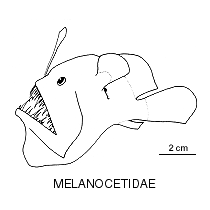- Classification
- ACTINOPTERYGII
- LOPHIIFORMES
- MELANOCETIDAE
-
Fish Classification
-
Class
ACTINOPTERYGII Ray-finned fishes -
Order
LOPHIIFORMES Anglerfishes -
Family
MELANOCETIDAE Blackdevils -
Genera
Melanocetus(3)
Family MELANOCETIDAE
More Info
|
Family Taxonomy |
A small family with a single genus and 6 species; a single genus with two species is known from Australian waters. |
|
Family Distribution |
Found worldwide in tropical and temperate areas of all major oceans; inhabit meso- and bathypelagic waters. |
|
Family Description |
Females - body short, deep, rounded, head short, eye small; mouth large, opening oblique or almost horizontal, jaw teeth long, fang-like, slender, recurved, and depressible. Dorsal fin with 12 or more rays, anal fin short-based with only 3-5 rays; pectoral fin radials 4, fusing to 3 with growth, pelvic fins absent. Illicium moderate to long, emerging on snout between eyes, biolumiscent esca conspicuous and bulbous. Skin smooth, dark, appearing naked. Males - free-living and much smaller and more elongate than females; jaw teeth absent, upper denticular with 2-3 series of strong recurved denticles, fused with median series of 3-9 enlarged dermal spines; lower denticular with 10-23 recurved denticles, fused into median and 2 lateral groups; eyes moderate, directed laterally, olfactory organs large; skin spinulose or naked. |
|
Family Size |
Females to 135 mm, males to 28 mm. |
|
Family Feeding |
Reported to feed on fishes and crustaceans. |
|
Family Reproduction |
Oviparous, fertilization external. Eggs are pelagic, presumably laid in buoyant, gelatinous rafts. Larvae are pelagic, about 2 mm at hatching, body short, spherical, skin somewhat inflated; pectoral fins not enlarged, pelvic fins absent. Larvae sexually dimorphic with rudimentary illicium of females visible on top of head. Larval metamorphosis begins between 8-10 mm SL. |
|
Family Commercial |
Of no commercial importance. |
|
Family Conservation |
None. |
|
Family Remarks |
Adult females have been found with scars on thier bodies, indicating that the tiny males, wihc are not parasitic, temporarily attach to females during breeding. |
|
Author |
Dianne J. Bray |
References
Bertelsen, E. 1951. The ceratioid fishes. Ontogeny, taxonomy, distribution and biology. Dana Rept. 39, 276 pp.
Bertelsen, E. 1984. Ceratioidei: Development and relationships. pp. 325-334, In Moser, H.G., W.J. Richards, D.M. Cohen, M.P. Fahay, A.W. Kendall, Jr. & S.L. Richardson (eds), Ontogeny and Systematics of Fishes. Spec. Publ. No. 1, Amer. Soc. Ichthy. Herpet., ix + 760 pp.
Bertelsen, E. & T.W. Pietsch. 1983. The ceratioid anglerfishes of Australia. Rec. Aust. Mus. 35(2): 77-99.
Munk, O. & P.J. Herring. 1996. An early stage in development of escae and caruncles in the deep-sea anglerfish Cryptopsaras couesi (Pisces: Ceratioidei). J. Mar. Biol. Assn. U.K. 76: 517-527.
Pietsch, T.W. 2005. Dimorphism, parasitism, and sex revisited: modes of reproduction among deep-sea ceratioid anglerfishes (Teleostei: Lophiiformes). Ichthyol. Res. 52: 207-236.
Pietsch, T.W. 2009. Oceanic Anglerfishes: Extraordinary Diversity in the Deep Sea. University of California press, 576 pp.
Pietsch, T.W. & Kenaley, C.P. 2005. Melanocetidae. Melanocetus. Blackdevils. Version 05 November 2005 (under construction). http://tolweb.org/Melanocetus/22003/2005.11.05 in The Tree of Life Web Project, http://tolweb.org/
Pietsch, T.W. & J.P. Van Duzer. 1980. Systematics and distribution of ceratioid anglerfishes of the family Melanocetidae, with description of a new species from the eastern North Pacific Ocean. U. S. Fish. Bull. 78(1): 59-87.










